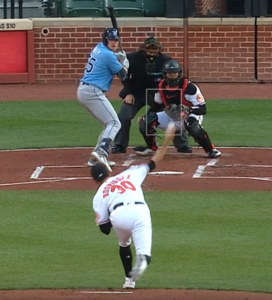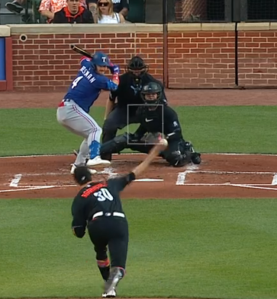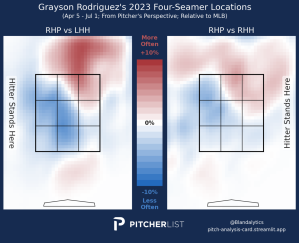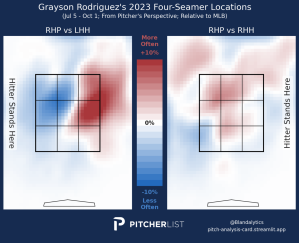Baltimore’s rebuild has gone perfectly. Annoyingly so, even. Each time the Camden Yard homer hose sprays a fan out in left field, I’m reminded of the youthful exuberance I once felt as a young lad in college two whole years ago. That memory has nothing to do with being sprayed with water from the depths of the Baltimore Inner Harbor, it’s more about having fun with your friends in the sun. I won’t sugarcoat it – I’m completely jealous. Gunnar Henderson, Adley Rutschman, and Jackson Holliday could relax a smidge with the whole “young, handsome, world is our oyster” thing they have going for them currently. Is this what my therapist is referring to when she says I’m “projecting?” Then again, can you (by you, I mean myself) really blame them?
The Orioles are coming off their best season in a long time. The farm system is still bloated with young position players, many of whom are blocked by more than established hitters at the big-league level. They cut off some of the excess fat this offseason, trading shortstop prospect Joey Ortiz (and pitcher DL Hall) to the Brewers for Corbin Burnes. The 2023 season established the Orioles as real contenders, a year or two ahead of schedule.
To supplement the rotation alongside the 2022 NL Cy Young Winner, the Orioles have Grayson Rodriguez and, hopefully, Kyle Bradish. Bradish was excellent in 2023, but an elbow injury could derail his season before it even begins. Rodriguez, a consensus top-10 prospect prior to the 2023 season, is slated to be the 1A to Burnes’s 1. Giving Rodriguez a 1A title may seem ambitious, given his overall rookie season statistics. His 104 ERA- ranked 10th among qualified rookie pitchers last season. His 93 FIP- was 5th, but still underwhelming given his reputation as a prospect. I’m advising everyone to buy back into the hype for Grayson Rodriguez. He’s my pick for the 2024 AL Cy Young Award.
His first 45 innings in the big leagues were rough: a 7.35 ERA and 5.90 FIP. Due to a home-run-per-fly-ball rate that was far and away the highest in baseball at 28%, his xFIP and SIERA were far more palatable (3.92 and 4.15, respectively), but they weren’t enough for the Orioles to keep him in the show. Rodriguez was demoted at the end of May, spent about a month in AAA, and returned to Baltimore halfway through July. Here are the differences in his game between those times.
I’m sure G-Rod would’ve experienced positive regression had he stayed with the big-league club throughout June. As I said, there are multiple ERA estimators suggesting bad luck was at play in his first stint with the club. Had Rodriguez’s end-of-season ERA approached the xFIP and SIERA marks from above – and there’s reason to believe that would’ve happened – the year would’ve been an unequivocal success. Still, the Orioles felt that the hard contact he allowed was not entirely bad luck, so they decided to send Rodriguez down to Triple-A.
The struggles were two-fold: First, some of that brutal home-run-per-fly-ball rate from earlier was deserved, as the 12.7% barrel rate G-Rod allowed was the 4th worst in baseball at that point. By no means were the home runs he allowed in the first half cheapies, if you will. Second, Rodriguez had a reliever-like 13.6% walk rate against lefties. Those two elements – getting off hitters’ barrels and throwing strikes against lefties – were the low-hanging fruit in his game.
A Mechanical Change That Paid Dividends
Rodriguez significantly changed his delivery and release during his time back in Triple-A. He went from an over-the-top to a three-quarters release point by way of a 0.30-foot horizontal widening and a 0.17-foot vertical dropping. Notice in the images below how the ball moves from inside the strike zone at release (first half) to just outside the zone at release (second half).

Rodriguez’s 1st Half Release Point

Rodriguez’s 2nd Half Release Point
The results of this mechanical change were simple: it kept him off of hitters’ barrels. Among qualified pitchers, G-Rod’s fastball had far and away the biggest drop in barrel rate between the first and second halves.
The outcome-based metrics on his fastball improved across the board, with decreases in exit velocity and fly-balls. The slight move in release point closer to righties gave hitters a more uncomfortable look. The ground ball rate on his fastball nearly doubled in the second half, with the majority of those gains coming against right-handed hitters.
More generally, the fastball adjustment helped Rodriguez command the pitch better. In what is no doubt a causation of lowering his release point, Rodriguez’s fastball location subsequently began to drop. Prior to his demotion, the fastball had a tendency to miss up in the zone to both lefties and righties, which is good for generating whiffs on swings (29% whiff rate – 83rd percentile) but not as good for generating swings themselves (49% swing rate – 50th percentile). Notice how in the first half, Rodriguez threw too many uncompetitive fastballs above the zone. He filled up the strike zone much more in the second half. Shoutout to Kyle Bland for my new favorite pitch location visualizations. Absolutely elite stuff.


The fastball zone, first-pitch strike, and overall swing rate saw a significant increase following the adjustment. Moreover, Rodriguez’s overall ahead rate (% of pitches ahead in the count) made gargantuan strides, going from the 18th percentile in the first half to the 99th percentile in the second half, a leap that’s enough to explain the excellent end to his season (I like looking at ahead rate, because it’s a decent proxy for strikeout/walk rate, but also correlates well to throwing more pitches that can garner chases).
The 70-Grade Changeup Came Back
The fastball adjustment was the biggest reason Rodriguez’s rookie season came to a strong close, but his changeup also made huge progress. The changeup was Rodriguez’s most renowned pitch as a prospect, garnering a 70/70 grade from FanGraphs. Through the first half, however, it was pretty much league average in terms of whiff, swinging strike, and chase rate. The pitch’s 45% ground-ball rate was particularly poor, clocking in well below league average for changeups.
Where the fastball positively impacted batted ball quality against righties, it was Rodriguez’s changeup that stifled lefties. In concordance with his fastball, his changeup gained a tick of velocity yet simultaneously saw a 2.7-inch drop in induced vertical break. That combination – increased changeup velocity and drop – is rare. An improvement in both of those areas of any pitch isn’t common. So, although the velocity gap between his fastball and changeup remained the same, the movement gap increased by over two inches of induced vertical break.
Those changes suppressed lefties’ batted ball quality against Rodriguez, making the pitch that Rodriguez was known for going into the season relevant once again.
In totality, the changeup’s 67% ground-ball rate in the second half was the 7th highest among pitchers with at least 25 offspeed pitches hit in play.
Projection and Expectations
The major projection systems all expect Grayson Rodriguez to have an excellent sophomore season. Steamer is the highest on him, projecting a 3.65 ERA, a 26.1% strikeout rate, and an 8.1% walk rate. I would take the under on his ERA for two reasons. First, G-Rod plays in Camden Yards, which suppressed right-handed home runs by 34% in 2023. His home run rate against righties was actually quite good in 2023. I expect that to continue in 2024, as G-Rod has dabbled with adding a sinker to his repertoire in spring training. The real issue was lefties, which brings me to the second reason I’m taking the under on his ERA. I already touched on the changeup’s improvement, but the overall surface-level gains he made in the second half against lefties are massive: a 14-point increase in groundball rate, a 9.7-point drop in barrel rate, and a 133-point drop in xwOBAcon. Moreover, the underlying data (stuff+, release point, pitch movement) suggests the results are sustainable. His 1.63 HR/9 against lefties in 2023 is going down in 2024.
His HR/9 went from ghastly in the first half (2.58) to pristine in the second (0.35). The projection systems think he’ll end up somewhere in the middle this coming season, with Steamer coming in at a reasonable 1.11 homers per 9. His ERA will be ~3.40 if the home run rate is closer to 1.00, which I expect it to be. In the past week, G-Rod has been the 18th starting pitcher selected in NFBC drafts, behind guys like Aaron Nola and Freddy Peralta. That makes little sense to me, especially given the Orioles offense and bullpen will supplant him with plenty of wins. I would take Rodriguez right around the Kevin Gausman, Yoshinobu Yamamoto area. Ambitious, I know. I have a decent track record with this kind of stuff, touting Nick Pivetta as my “guy” last season. That take got me annihilated on Twitter; Phillies fans really have something against Pivetta. I don’t expect the same level of hate this season. Most people know that Grayson Rodriguez is awesome. I just don’t think they know how awesome.

I don’t think the photo at the top of the article is Grayson Rodriguez. I’d guess that it’s Ryan McKenna.
That is definitely Ryan McKenna in the beard. I respect the Pitcher’s List, which is why I’m actually commenting. Keep doing great work (but make sure those photos are straight, or no one will read).